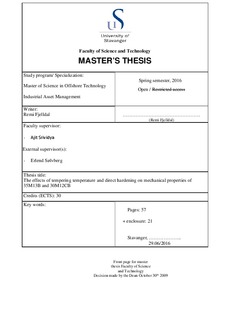| dc.contributor.advisor | Srividya, Ajit | |
| dc.contributor.author | Fjelldal, Remi | |
| dc.date.accessioned | 2016-11-30T09:10:38Z | |
| dc.date.available | 2016-11-30T09:10:38Z | |
| dc.date.issued | 2016-06 | |
| dc.identifier.uri | http://hdl.handle.net/11250/2423594 | |
| dc.description | Master's thesis in Offshore Technology | nb_NO |
| dc.description.abstract | In this work the mechanical properties of the wear parts with respect to the different heat treatments applied have been investigated. Two different alloys and a total of nine different heat treatment procedures were tested. Alloy 35M13B have been tested with respect to tempering temperature and represents one wear part. The other wear part 30M12CB have been tested with respect to both tempering temperatures and effect of direct hardening.
The main goal of this work has been to improve the understanding of how the steel alloys used for the wear parts responds to different tempering temperatures and heat treatments.
During this work both alloys were tested using the following test methods; charpy impact testing, tensile testing and Vickers hardness testing. From production, wear part 30M12CB as currently produced and when directly hardened was to be investigated for its mechanical properties, thus alloy 30M12CB was heat treated at different temperatures with the aim to find two heat treatments that would match the wear parts pulled from production. The two chosen temperatures for 30M12CB were 850*C representing the current production and 1100*C representing direct hardening. Then, wear parts 30M12CB and 35M13B was heat treated accordingly and tempered. The current tempering temperature of 220*C was compared with 180*C and no tempering.
Charpy test specimens and tensile test specimens for 35M13B and 30M12CB were then tested with three parallels. The results recorded was then compared with respect to mechanical properties for the different tempering temperatures and heat treatments.
For all parts the strength increased slightly by lowering tempering temperature from 220*C to 180*C.
No tempering did not affect the ductility of 35M13B and improved the strength and hardness for this alloy, in contrast no tempering left 30M12CB-850 very brittle.
Directly hardening wear part 30M12CB will result in a slight reduction in quality, however the difference in quality will likely be slightly greater than the results from this work indicates.
It is reasonable to say that reducing the temperature of tempering for 35M13B may be preferable as it saves space, reduces production time and cost, while maintaining or increasing the hardness and strength of the material. Further, the slight reduction in ductility should not lead to brittle fractures and thus may not affect the end product negatively. | nb_NO |
| dc.language.iso | eng | nb_NO |
| dc.publisher | University of Stavanger, Norway | nb_NO |
| dc.relation.ispartofseries | Masteroppgave/UIS-TN-IKM/2016; | |
| dc.subject | tempering | nb_NO |
| dc.subject | direct hardening | nb_NO |
| dc.subject | steel heat treatment | nb_NO |
| dc.subject | offshore teknologi | nb_NO |
| dc.subject | offshore technology | nb_NO |
| dc.subject | driftsledelse | nb_NO |
| dc.title | The effects of tempering temperature and direct hardening on mechanical properties of 35M13B and 30M12CB | nb_NO |
| dc.type | Master thesis | nb_NO |
| dc.subject.nsi | VDP::Technology: 500::Marine technology: 580::Offshore technology: 581 | nb_NO |
